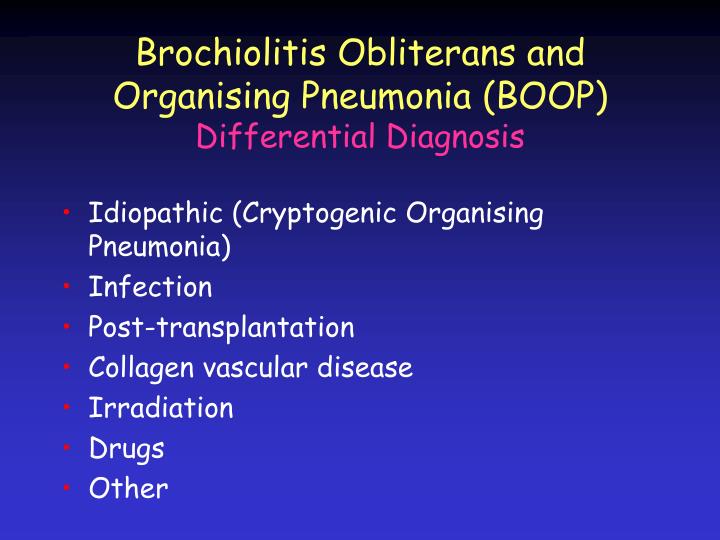

Respiratory failure leading to death may occur in 5% of patients. This type of therapy is often effective in patients with associated systemic disorders or in other clinical settings, but there may be limited or no response in patients with dermatomyositis, immunosuppression, or interstitial opacities at the lung bases. In idiopathic BOOP, complete resolution occurs in 65% to 85% of patients treated with corticosteroid therapy. There are numerous related disorders, including human immunodeficiency virus infection, radiation therapy, thyroiditis, and alcoholic cirrhosis. These include the connective tissue disorders, antineoplastic and other drugs, and immunological disorders, as well as bone marrow and lung transplantation. It is also associated with a variety of systemic illnesses and clinical settings. It is generally idiopathic, but it may occur during the resolution of a viral or mycoplasma pneumonia. Pulmonary function studies of patients show a decreased vital capacity, normal flow rates (except in smokers), and a decreased diffusing capacity. Clinically, a flu-like illness, cough, and crackles are common. It is defined as granulated tissue plugs within lumens of small airways that extend into alveolar ducts and alveoli. It is a diagnostic consideration in patients with a febrile flu-like illness of a few weeks' duration and a roentgenogram showing bilateral patchy infiltrates that are not responsive to a typical course of antibiotics. In cancer patients, the evaluation of new pulmonary symptoms accompanied by radiographic changes should include a consideration of this diagnosis.Bronchiolitis obliterans organizing pneumonia (BOOP) is increasingly recognized as an important cause of diffuse infiltrative lung disease. BOOP can mimic pulmonary malignancy and pulmonary infection. In conclusion, For cancer patients, BOOP represents a treatable cause of lung disease with protean manifestations. The vast majority of patients recovered from this condition. We observed the opposite pattern in patients with hematologic malignancies (22% vs.67%). Its sometimes called bronchiolitis obliterans organising pneumonia (BOOP). Patients with solid organ tumors were more likely to have nodular or mass like radiographic abnormalities (81%) than to have diffuse infiltrates (19%). Cryptogenic organising pneumonia (COP) is a rare lung condition and a type of. The only clear relationship between the underlying malignancy and the diagnosis of BOOP at presentation was in the chest radiographic findings. The symptom patterns were non-specific, as were the physiological abnormalities. BOOP was encountered in patients with a variety of clinical presentations, and many types of malignancies. Forty-three patients with an underlying diagnosis of cancer were found on lung biopsy to have BOOP as an isolated entity. The type and treatment of primary cancer, clinical and radiographic features of initial BOOP presentation, and outcome following therapy were recorded. We conducted a retrospective study of patients with BOOP at Memorial Sloan–Kettering Cancer Center, New York, NY, U.S.A. The presentation of this treatable condition in cancer patients has not been described in any large series. Bronchiolitis obliterans with organizing pneumonia (BOOP) is an infrequently encountered clinical condition that can mimic a number of other pathologic lung processes.


 0 kommentar(er)
0 kommentar(er)
